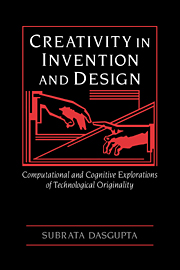Book contents
- Frontmatter
- Contents
- Preface
- Acknowledgments
- Part I Creativity in invention and design: issues and ingredients
- 1 Creativity, invention, and the computational metaphor
- 2 A computational theory of scientific creativity
- 3 Maurice Wilkes and the origins of microprogramming: the historical setting
- Part II The invention of microprogramming: a cognitive explanation
- Part III Reflections on the nature of inventing
- Appendix
- References
- Index
1 - Creativity, invention, and the computational metaphor
Published online by Cambridge University Press: 23 December 2009
- Frontmatter
- Contents
- Preface
- Acknowledgments
- Part I Creativity in invention and design: issues and ingredients
- 1 Creativity, invention, and the computational metaphor
- 2 A computational theory of scientific creativity
- 3 Maurice Wilkes and the origins of microprogramming: the historical setting
- Part II The invention of microprogramming: a cognitive explanation
- Part III Reflections on the nature of inventing
- Appendix
- References
- Index
Summary
Among the many features of the mind that humans have chosen to speculate on, few evoke a greater sense of enigma than creativity. Believing that as a cognitive act it stands well beyond the humdrum, we pay special homage to those whose occupations are thought to be intrinsically creative: artists, scientists, writers, musicians, and inventors. Recognizing further that even among them there are a few whose works are so very special and so far transcend the achievements of the rest, we accord them extra reverence; we often bestow on them the appellation “genius”; we wonder, sometimes in awe and not without a tinge of envy, about their mental makeup; and we ponder the nature of the process their minds have enacted in arriving at a particular poem, symphony, theory, or artifact.
We see evidence of this compelling interest in creativity in many distinct forms. The very best type of biography, for instance, embodies an engagement on the part of the biographer with his or her subject's life and work. The biographer's task is to comprehend how childhood, social background, worldview, intellectual influences, personal relationships, and so on may have affected, perhaps even serve as an explanation of, the subject's particular acts of creation. In Richard Ellman's (1982) biography of James Joyce, there is a chapter titled “The Backgrounds [sic] to ‘The Dead’” in which the main elements of this short story – its characters, the setting, even the basic plot – are explained or elucidated by Ellman in terms of Joyce's own background and experience.
- Type
- Chapter
- Information
- Creativity in Invention and Design , pp. 3 - 50Publisher: Cambridge University PressPrint publication year: 1994



